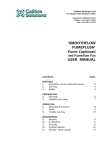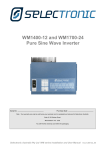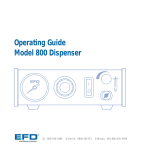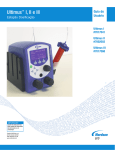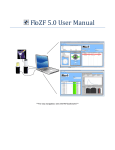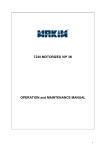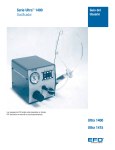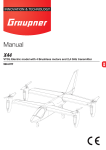Download here for pdf user handbook
Transcript
Calibre Solutions Ltd 145 Hepburn Rd, Waitakere 0602 Freephone: 0800 422 542 Phone: +64 9 813 1303 Fax: +64 9 813 1319 ‘SMOOTHFLOW STUDENT’ Fume Cupboard and Fumeflow Fan USER MANUAL CONTENTS: FEATURES 1. 2. 3. Smoothflow Fume Cupboard Features Sash Stop Baffles PREPARATION 4. Warning! 5. Guidelines for Safety OPERATION 6. Operating Instructions 7. Faults 8. Trouble shooting MAINTENANCE 9. Monthly 10. Six Monthly 11. Annually DRAWINGS COMMISSIONING & REPORTS Calibre Solutions Ltd Smoothflow Student Manual Page 2 of 12 Smoothflow Fume Cupboard Features Microprocessor controller controls all aspects of operation via the control keypad the controller is located on top of the fume cupboard RCD* protection device for the power sockets battery* energy for the mains power failure alarm *refer maintenance instructions Light illuminates the work area the light is located on top of the fume cupboard Sash stop limits the opening height of the sash in normal operation releases the sash to full height for service access located on the left front pillar Calibre Solutions Ltd Smoothflow Student Manual Page 3 of 12 Smoothflow Fume Cupboard Features (cont.) Control keypad input keys to start, stop and activate the fume cupboard displays the fume cupboard status and alarms *refer operating instructions located on the right front pillar Power outlet double socket for electrical appliances availability of power strictly controlled *refer operating instructions located on the right front pillar Label important user information spillage capacity warning notice fume cupboard serial number located on the right corner of the sash Water valve controls water flow to water spout inside the fume cupboard located under the sill Gas valve controls gas flow to gas spout inside the fume cupboard flammable gases have push-turn mechanism availability of flammable gases strictly controlled *refer operating instructions located under the sill Calibre Solutions Ltd Smoothflow Student Manual Page 4 of 12 SASH STOP The sash stop is located on the left front pillar The sash stop limits the sash opening height to about 480mm. With the opening restricted, less air flow is required to achieve fume capture. The sash can be released for maximum opening for cleaning inside the fume cupboard, or setting up equipment before the work starts. ALWAYS lower the sash before commencing work NEVER use the fume cupboard with the sash above the stop. To release the sash: Raise the sash until it reaches the upper stop position 1. Insert a coin or key in the slot of the sash stop 2. Twist the sash stop clockwise about a quarter turn and hold 3. Raise the sash above the stop Release the stop and withdraw the coin or key. The stop will automatically reset when the sash is lowered ALWAYS lower the sash before commencing work. NEVER use the fume cupboard with the sash above the stop. BAFFLES There are two baffles in the fume cupboard. The baffles are easily removed to facilitate cleaning of the entire fume chamber. This should be done as often as the work requires, and at least monthly (refer maintenance instructions) ALWAYS remove ALL chemicals and equipment from the fume cupboard. ALWAYS wear personal protective equipment before handling baffles. Protective equipment must be suitable for the chemicals used inside the fume cupboard. Refer to Supervisor. Minimum requirements are overalls or coat with long sleeves; suitable eye protection - glasses, goggles or mask; and suitable gloves. Calibre Solutions Ltd Smoothflow Student Manual Page 5 of 12 Front Baffle The front baffle hangs just behind the bypass grille and sash (see drawing). The clear PVC baffle hangs from two hooks, one on each sash guide. Carefully lift the baffle off both hooks at once to avoid fracture of a hook. Replace the baffle by reverse action. Carefully hang the baffle on both hooks at once to avoid fracture of a hook. Rear Baffles The rear baffles are sprung between a row of hooks inside the back of the fume cupboard, and a corresponding row of hooks under the roof (see drawing). The baffle is in two pieces, with a vertical join in the centre. The join cover strip is attached to the RIGHT hand baffle. Remove this baffle first. 1. 2. 3. 4. To remove the baffle, place both (gloved) hands, palms up, under the bottom edge of the baffle. Raise the baffle and bring it forward, over the hooks. Bring the bottom edge of the baffle forward over the sill, Disengage the top edge of the baffle from the upper hooks. Repeat the action with the left baffle. Replace the baffles by reverse action. 5. Replace the left baffle (without cover strip) first. Hold the baffle with the edge notch at the top left corner, and the slots offset towards the centre of the fume cupboard (see diagram). 6. Lift the baffle into the fume cupboard and engage the top edge of the baffle in the upper hooks. 7. Lift the bottom edge of the baffle over the sill, 8. Carry the baffle to the back of the fume cupboard, and lift the bottom edge onto the rear hooks. 9. Check alignment in top and bottom hooks. 10. Hold the right baffle with the edge notch at the top right corner, and the cover strip towards the centre of the fume cupboard. 11. Repeat actions 6 - 9 above with the right baffle. Calibre Solutions Ltd Smoothflow Student Manual Page 6 of 12 1. ................... 2. .................. 3. .................. 4. .................. 5. .................. WARNING Spillage volume 20 L Observe chemical limits specified by Supervisor No ignition sources in sump ISOLATE FUME CUPBOARD in case of spills or fire Smoothflow Fume Cupboard Serial No. XXX Calibre Plastics Ltd Auckland The label located at the bottom right corner of the sash has important user information. 1. The spill containment volume of this fume cupboard is stated on the label. The Supervisor may use this volume to limit quantities of chemicals permitted in the fume cupboard. 2. BEFORE the fume cupboard is used, the Supervisor is responsible for carrying out a RISK ANALYSIS of the work. Consider the nature of chemicals and processes to be used, to determine limiting quantities of hazardous, flammable, oxidizing and corrosive substances allowed within the fume cupboard. Remember that all liquids within the fume cupboard (including water) may displace other substances during an incident. The supervisor is to make a list of chemical quantity limits, which is to be readily accessible to all persons using the fume cupboard. 3. Ignition sources are not to be placed within the sump of the fume cupboard. 4. In the event of a spill or fire, ISOLATE the fume cupboard. Press the (red) “fume cupboard emergency isolator” button on the keypad. This will immediately shut off the power and flammable gas outlets. The fan will keep going. Refer operating instructions. 5. The serial number of this fume cupboard may be requested when seeking technical support, available Toll Free in New Zealand: 0800 422 542 Calibre Solutions Ltd Smoothflow Student Manual Page 7 of 12 GUIDELINES FOR USING FUME CUPBOARDS The fume cupboard is a ventilated work space designed aerodynamically for the safety of the operator. It will not work properly if it is cluttered up with excess equipment or vessels, which affect the air flow. Before starting work, clean out the fume cupboard. Remove everything which is not needed. All chemicals from the fume cupboard should be removed to a suitable store. Cleaning the internal surfaces will reduce the risk of contamination. It will also reduce the risk of mixing incompatible substances. Before starting work, refer to the Laboratory Supervisor’s risk analysis and schedule of chemical quantities permitted in the fume cupboard. Make sure that the fume cupboard is suitable for the intended use, and has enough space to do the work safely. Adopt work methods that minimise the release of fumes. Consider appropriate quantities of substances involved, the rate of reaction, and design of apparatus. Make sure the fume cupboard is working. Start up the fume cupboard (see operating instructions), and check the status of all alarms, especially air flow. Look around the room and close any windows or doors which could cause cross-draughts Set up all the equipment required for the work inside the fume cupboard, with sufficient quantity of reagents. Position apparatus and materials near the centre and rear of the work space. Ignition sources are not to be placed within the sump of the fume cupboard. Check that a suitable fire extinguisher is at hand. The fume cupboard is now ready for use. Wear protective equipment appropriate to the task. Keep the sash lowered as much as practical during use. In the event of a spill or fire, ISOLATE the fume cupboard. Press the (red) “fume cupboard emergency isolator” button on the keypad. This will immediately shut off the power and flammable gas outlets. The fan will keep going. Refer operating instructions. After use, dispose of waste substances with due regard for their potential to create hazards, and within the rules of the local water authority. Refer also to the Laboratory Supervisor, and the laboratory risk analysis. Maintain the fume chamber in clean condition to avoid chemical contamination and damage to the fume cupboard. Remove unused chemicals to a suitable store. Do not use a fume cupboard for storage of chemicals. Lower the sash. STUDENT FUME CUPBOARD EMERGENCY ISOLATOR RED PRE-PURGE POST-PURGE AIRFLOW GREEN TEMPERATURE SCRUBBER READY YELLOW POWER & GAS SPRAY BAR OPERATING THE FUME CUPBOARD Start up Press the green button The fan and light turn on The TEMPERATURE LED will be green The controller waits 7 seconds for airflow Pre-purge The AIRFLOW LED turns green The PRE-PURGE LED will be amber for 50 seconds then flash for another 10 seconds, then go out Ready The READY LED turns green Four beeps sound Active Press the yellow button The POWER & GAS LED turns green The fume cupboard is now operational power & gas can be used Isolate / Ready Press the red button Power & Gas turn off automatically The POWER & GAS LED goes out The READY LED turns green Press the yellow button to re-activate, or Shut down Press the red button again Post-purge The fan and light continue to operate The POST-PURGE LED will be amber for 4 minutes then flash for another 1 minute, then go out. The light and fan turn off automatically Re-start Press the green button to return from post-purge to pre-purge Calibre Solutions Ltd Smoothflow Student Manual Page 9 of 12 FAULT ALARMS If the Power is cut, an alarm will sound a slow beep The READY LED will flash red Press the red button to mute the alarm A long beep will sound as the controller shuts down. When the Power is restored, The fan will automatically turn on for 20 minutes then turn off; An alarm will sound for 30 seconds, then turn off The LED's will keep flashing. Press the red button to reset the controller and stop the fan. Press the green button for normal start up. If the Airflow gets low An alarm will sound , and the AIRFLOW LED will flash Press the red button to mute the alarm The fume cupboard will go into normal post-purge, but the AIRFLOW LED will be red Check out what caused the alarm. Get it fixed before using the fume cupboard again. If the Temperature inside the fume cupboard gets high The TEMPERATURE LED will flash green as a warning Turn down the heat inside the fume cupboard If the temperature inside the fume cupboard gets higher An alarm will sound , and the TEMPERATURE LED will flash Press the red button to mute the alarm The fume cupboard will go into normal post-purge, but the TEMPERATURE LED will be red Check out what caused the alarm. Get it fixed before using the fume cupboard again. The temperature sensor works even when the fume cupboard is turned off. Press the red button to mute the alarm TECHNICAL SUPPORT FREEPHONE 0800-422-542 Calibre Solutions Ltd Smoothflow Student Manual Page 10 of 12 TROUBLE SHOOTING No power at power socket Power is made available to the socket outlet only during “Active” status. Refer operating instructions. After the pre-purge is complete and the Ready LED lights up green, press the yellow button to activate the power outlet. If the Power & Gas LED is lit up and there is still no power, check the RCD breaker (the blue switch visible in the lid of the control box on top of the fume cupboard). When it is on, the switch lever is inclined toward the back of the fume cupboard. If the switch will not latch on, there is an electrical fault in the circuit. Call an electrician. No gas at gas outlet Gas is made available to the outlet only during “Active” status. Refer operating instructions. After the pre-purge is complete and the Ready LED lights up green, press the yellow button to activate the gas outlet. If the Power & Gas LED is lit up and there is still no gas, check the RCD breaker (the blue switch visible in the lid of the control box on top of the fume cupboard). When it is on, the switch lever is inclined toward the back of the fume cupboard. If the switch will not latch on, there is an electrical fault in the circuit. Call an electrician. If the power socket is live but there is still no gas, the gas mains may be isolated. Some laboratories have a master gas isolator. Controller does not respond to keypad If the control sequence has become corrupted, the controller needs to re-load the program from memory, which happens automatically on power restore. The mains isolator switch is visible in the lid of the control box on top of the fume cupboard. The mains isolator is the switch on the left. When it is on, the switch lever is inclined toward the back of the fume cupboard. Turn off mains supply to the fume cupboard controller. Wait 5 seconds, then turn the mains isolator on again. The processor will reboot, and signal a power restore alarm (see operating instructions) Press the red button to reset the controller, and start the fume cupboard as normal. Calibre Solutions Ltd Smoothflow Student Manual Page 11 of 12 MAINTENANCE BEFORE undertaking any maintenance of the fume cupboard, obtain a summary of chemical or other hazards from the laboratory supervisor BEFORE undertaking any maintenance of the duct or fan, isolate the power supply and tag the fume cupboard “system under maintenance - do not use” Monthly Maintenance Remove all chemicals and equipment from the fume chamber. Remove the rear baffles as described in Section 3 of this manual Clean the fume chamber with dilute detergent Replace the baffles Test the RCD (earth leakage) circuit breaker Refer to “Features” Section of this manual for location of the RCD. Press the blue “Test” button. The breaker should immediately trip “off” Reset the breaker to the “on” position. Six Monthly Maintenance In addition to monthly tasks, clean the fluorescent light tube, and the light panel in the roof of the fume chamber. Inspect and maintain fans, motors, drive belts and bearings Check all plastic bolts, and replace if UV-brittle. Perform smoke and velocity tests as AS/NZS 2243.8 Appendices F and E Submit a maintenance and test report to the laboratory supervisor Annual Maintenance In addition to six monthly tasks, carefully inspect the fume chamber for defects, and repair as required. Check the sash counterweight cords for wear. Ensure that service controls and outlets are in good condition. Check operation of controller and automatic isolators. Replace 9V battery for power failure alarm Refer to “Features” Section of this manual for location of the battery. Lift and pull the battery drawer on the front of the control box. Observe polarity carefully when fitting the new battery. Close the battery drawer. Inspect the exhaust duct from fume chamber to stack Assess the whole system for compliance with AS/NZS 2243.8 Perform smoke and velocity tests as AS/NZS 2243.8 Appendices F and E Submit a maintenance, audit and test report to the laboratory supervisor. Affix a label to the fume cupboard showing date of inspection and overall test result. Calibre Solutions Ltd Smoothflow Student Manual Page 12 of 12 COMMISSIONING Refer the operating instructions Turn the power on and reset the controller. Start the fume cupboard. If the airflow alarm goes off, mute the alarm. Measure the airflow Raise the sash to the maximum operating position (sash stop) Measure the air velocity in the plane of the sash at six (6) positions 100+ 100+ 100mm + + 100mm +100 +100 The average velocity must be more than 0.5 m/sec. We recommend commissioning to 0.55 m/sec. Adjust the fan speed as below. Record the velocity measurements in a commissioning report. Conduct a smoke test (AS/NZS 2243.8) and record the observations. Adjust the fan speed (Fumeflow T250 fan): The Fumeflow T250 fan is usually installed above the roof. There is a speed regulator in a plastic box beside the fan motor. Adjust the speed regulator clockwise to increase speed, or anti-clockwise to reduce speed. When the correct speed is set for fume cupboard face velocity, apply a bead of silicone sealant to the speed regulator shaft Adjust the airflow alarm sensor (pressure switch): The pressure switch is mounted in the lid of the fume cupboard controller. Adjust the white plastic cross-head screw clockwise to raise the set point (more sensitive) or anticlockwise to reduce the set point (less sensitive). A practical guide: 1. Turn the set point up until the Airflow alarm sounds 2. Press the red button to mute the alarm. 3. The Airflow LED should still be red. 4. Turn the set-screw down until the LED turns green. To check the alarm, pull the clear PVC pilot tube out of the duct. The alarm should sound after 2-3 seconds. Ensure the pilot tube is re-fitted in the duct.












